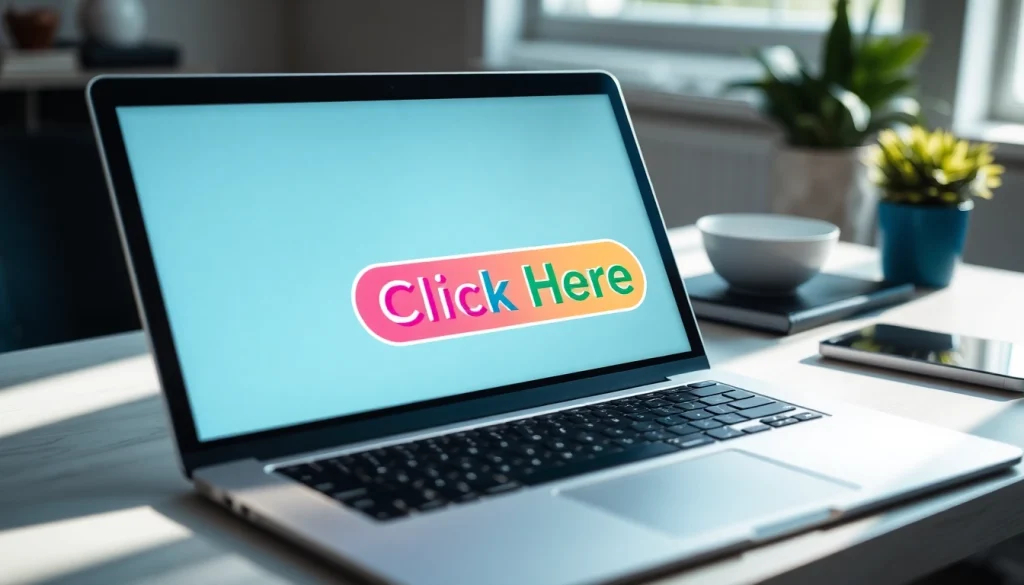In the digital age, how we communicate and interact with content online has become critically important. The phrase “click here,” often seen in digital content, is a common call to action that many marketers and web designers use. However, it’s time to rethink this practice and explore more effective alternatives that enhance user experience and drive engagement. To delve deeper into this topic, Click Here to discover insights about leveraging clickable content more effectively. This article offers an in-depth analysis of the implications surrounding the use of “click here,” its impact on SEO, user engagement, and accessibility, along with strategies for improvement.
Understanding the Impact of “Click Here” on User Experience
Define the Problem: Vague Hyperlinks
When users encounter a hyperlink labeled “click here,” they are often left without context regarding what to expect when they follow the link. This vagueness can lead to frustration, decreased engagement, and ultimately, lost conversions. The problem becomes clear when we consider that users tend to scan content rather than read it thoroughly. By using generic phrases as link text, we detach the link from the very content or action it relates to, diluting its effectiveness.
Why Clarity Matters in Link Text
Clarity in hyperlink text is essential for guiding users smoothly through their online journey. It enhances their understanding of the action they are about to take and the value they will receive. For example, instead of instructing a user to “click here,” providing descriptive text like “subscribe to our newsletter for the latest updates” informs them of the content behind the link. This method not only improves user experience but also builds trust and makes navigation more intuitive.
User Preferences and Behavior Regarding Links
Research into user behavior shows that meaningful link text can result in higher engagement rates. Users prefer links that offer insight into what they’ll find on the other side. This behavior is particularly crucial for users who rely on screen readers or other assistive technologies. Vague phrases can hinder their ability to navigate websites effectively, leading to frustration and a higher likelihood of abandoning the page. A user-centered approach must prioritize clear, informative link text to serve a broader audience.
Alternatives to “Click Here”: Enhancing Engagement
Effective Call-to-Action Phrases
To replace “click here,” consider using more engaging and actionable phrases tailored to your content. Effective call-to-action (CTA) examples include:
- “Join our community today!”
- “Download your free guide now!”
- “Learn more about our services.”
- “Get started with your trial!”
These phrases not only tell the user what action to take but also convey a sense of benefit. Engaging CTAs can improve click-through rates significantly, leading to better overall performance for your digital communications.
Improving Accessibility with Specific Language
Accessibility is a key consideration in web design, and the choice of link text plays a crucial role. Specific language benefits all users, especially those who utilize assistive technologies. Clear anchor text allows screen readers to provide contextual information, improving the experience for visually impaired users. By avoiding “click here,” you create a more user-friendly environment that can cater to a diverse audience without compromising on clarity.
Examples of Engaging Link Text
Here are some examples of effective link texts based on various contexts:
- Newsletter Signup: “Stay updated—subscribe to our newsletter!”
- Product Purchase: “Shop the latest collection now!”
- Resource Download: “Access your free eBook here.”
- Service Inquiry: “Get your personalized quote today!”
These recommendations illustrate that thoughtful link text can effectively convey purpose and build a connection with the user, encouraging them to take action.
The Role of SEO in Link Text Choice
How Link Text Affects SEO Rankings
From an SEO perspective, link text plays an integral role in how search engines interpret the content of the linked page. Using descriptive and keyword-rich anchor text improves the relevancy of your links, positively impacting your site’s search rankings. For instance, a link labeled “best organic gardening tips” not only informs users but also signals to search engines what the linked content is about, improving the likelihood of ranking higher in relevant searches.
Best Practices for Optimizing Anchor Text
To optimize anchor text effectively, consider implementing the following best practices:
- Use Descriptive Language: Ensure your link text accurately describes the destination content.
- Avoid Generic Terms: Steer clear of words like “click here” or “this link” as they provide no context.
- Incorporate Keywords: Where appropriate, use relevant keywords that align with both your content and your audience’s search behavior.
- Limit Link Length: Keep your link text concise, ideally under 60 characters, to ensure clarity without overwhelming users.
By following these practices, you can enhance both user experience and search engine optimization.
Case Studies of Successful Link Strategies
Several companies have effectively transformed their link strategies to drive better performance. For example, an e-commerce site that implemented detailed, keyword-rich links reported a 25% increase in organic traffic over six months. Similarly, a blog focused on personal finance shifted from generic link text to more actionable CTAs, resulting in a 40% increase in newsletter signups. These case studies demonstrate that intentional link text can lead to significant improvements in user engagement and conversion rates.
Testing and Measuring Success
A/B Testing Different Call-to-Action Phrases
A/B testing is a powerful method for refining your link text. By presenting different versions of a page with varying CTAs, you can gather data on user interactions. For example, test versions of a button that say “Get Started” versus “Join the Revolution” and analyze which generates a higher click-through rate. This data can guide your decisions on link text, ensuring you choose the most effective phrases for your audience.
Measuring Click-Through Rates and User Engagement
Utilizing tools like Google Analytics enables you to track click-through rates (CTR) and user engagement metrics associated with specific links. Observing patterns in these metrics can highlight which link texts resonate best with your audience. A higher CTR might indicate an effective message, while lower rates can reveal a need for reevaluation and testing of link strategies.
Understanding User Feedback for Continuous Improvement
Gathering direct feedback from users about their experiences navigating your site provides invaluable insight into link effectiveness. Surveys, user interviews, and feedback forms can help you understand their preferences and challenges when engaging with your content. By continually refining your approach based on user input, you can enhance the overall quality of your digital communication.
Conclusion: The Future of Link Text in Digital Communication
Embracing Change for Better User Interaction
The digital landscape is ever-evolving, and so are user expectations. Moving away from vague terms like “click here” in favor of more descriptive and engaging link texts will foster better user interaction and satisfaction. Taking this step reflects a deeper understanding of user needs and illustrates a commitment to maintaining a high-quality web experience.
Trends in Web Design and Content Strategy
As digital content continues to grow, trends will shift towards inclusivity and engagement. Innovative designs that integrate intuitive navigation will highlight clear, actionable phrases over generic terms. This approach will not only improve the aesthetic appeal of sites but will also support efforts to enhance accessibility.
Final Thoughts on Creating Meaningful Connections
In the end, the language we choose for our links can significantly affect users’ experiences and perceptions of our content. By opting for clarity, specificity, and accessibility, we create meaningful connections that drive engagement and conversions. Embracing this shift is essential for anyone involved in web content creation and marketing moving forward.



